Part 1 - Structure, Performance and the Collie Standard
By Kathy V. Moll, Deep River Collies
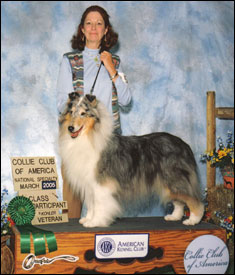 Collie structure is a multi-faceted, complex issue. Adding the component of performance to the mix is even more daunting. BUT, anyone who is a true student of the Collie needs to make a study of structure, ditto for anyone who is a student of herding, obedience, agility and the many other performance events open to our breed! I warned Gary and Karen that we might have to break this up into more than one article since there is so much to say, and also because anyone who knows me knows that I’m rarely at a loss for words! So this is Part 1 of my own studying over the past 34 years and, more importantly, that of many experts in the field of canine structure. Collie structure is a multi-faceted, complex issue. Adding the component of performance to the mix is even more daunting. BUT, anyone who is a true student of the Collie needs to make a study of structure, ditto for anyone who is a student of herding, obedience, agility and the many other performance events open to our breed! I warned Gary and Karen that we might have to break this up into more than one article since there is so much to say, and also because anyone who knows me knows that I’m rarely at a loss for words! So this is Part 1 of my own studying over the past 34 years and, more importantly, that of many experts in the field of canine structure.
Left: Kathy Moll at the 2005 National with
her Veteran.
In Part 1, we will examine what the Collie Breed Standard has to say about structure, and how the descriptions it provides relate to our breed’s abilities in performance. What structural characteristics seem to govern which abilities in performance such as endurance, jumping, balance, retrieving, dexterity and the like? What structural characteristics are most important in achieving goals in performance with our Collies?
As all collie lovers know, our dogs have big hearts and a desire to work for their pack leaders. Unfortunately, some of us are cruel to our collies without realizing it. Most collies will continue to try to work even when their structure tells them to stop, because they have “heart.” They will work for us as long as they can, sometimes until their bodies cannot take any more. People often mistake their collie’s change in work ethic for laziness or disobedience and treat the new developments as training problems. No new training technique can solve the problem. However, knowledge of structure can help you choose the right collie for performance and help you analyze a potential problem with the collie(s) you own now.
Let’s begin with my own chart used to evaluate my puppies before I place them. As we go along, we will use these terms to talk about form and function.
| FRONTS: |
SPINE & REAR: |
HEAD: |
| WITHERS |
NECK & ARCH |
SKULL |
| SHOULDER |
BACK |
BITE |
| UPPER ARM |
LOIN |
UNDERJAW |
| PROSTERNUM |
CROUP |
HEAD LENGTH |
| RIB SPRING & DEPTH |
TAIL SET & LENGTH |
FRONT |
| LEGS/ELBOWS |
ISCHIUM |
STOP |
| FRONT PASTERNS |
STIFLES |
CLEANNESS |
| FEET & TOES |
HOCKS/REAR PASTERNS |
EXPRESSION |
You may be thinking that head structure has naught to do with performance, not so! Those who want to minimize the beauty of the collie head as described in our standard, saying that collies show function solely through body structure and gait, miss the obvious. Our Standard calls for a headpiece with a “resemblance to a well blunted lean wedge . . . nicely balanced in proportion,” and an underjaw that is “strong and clean cut . . . Overshot or undershot jaws are undesirable.” These characteristics are a must for both retrieving and herding. Yes, herding!
A receding skull with its usual full stop, incorrect underjaw and probable bad bite will require special, larger than usual ends on dumbbells so that the collie can pick it up without scraping its face on the ground. As a result picking up the dumbbell and carrying it are uncomfortable and unbalanced in obedience. The teeth cannot properly secure the dumbbell or utility article if dentition is misaligned. Occasional “gripping” in the correct body spot on belligerent stock is definitely impeded by weak underjaws and bad bites. Making the head a secondary feature in our Collies is a big mistake. We want the WHOLE package for both beauty and functionality!
The Collie skeleton and musculature are illustrated below. They will be a helpful study guide, along with the chart above, for the rest of this discussion. A structurally sound collie is a joy to watch standing and moving. According to the Standard, a collie is, “a lithe, strong, responsive, active dog, carrying no useless timber.” Ours is a “trotting breed” that should look supple and graceful if correctly built. A sound collie should live a long, healthy life and be less susceptible to stress, injury, and fatigue than an unsound collie.
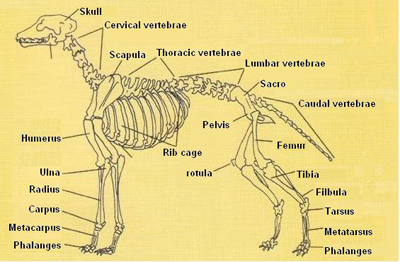
Collie Skeleton

Collie Muscles — Source: Collie Cues (1977)
Jumping for obedience and especially agility is repetitive and requires proper muscle and bone structure particularly in the front assembly. The scapula and upper arm (humerus) should be equal length. A proper shoulder layback (scapula/upper arm) in a collie is approximately 30 degrees. Forty five degrees is a myth disproved long ago as incorrect, even impossible, in dogs. Galloping breeds such as sighthounds should be less well laid back than our “trotting breed” and dogs with short legs in proportion to their bodies have slightly more layback. However, studies by experts, such as Rachel Page Elliott, demonstrate that a 45 degree layback would cause a dog of any breed to fall over. A well laid back shoulder provides better ground covering ability known as “reach.” For endurance sports, proper angles are essential.
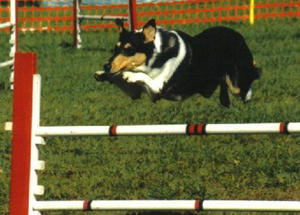 In addition to proper layback, lack of prosternum (pointed bone in the center of the chest) is a fault that will hinder performance ability. When sliding your hand across your collie’s chest, the center point should stick out to some degree, stopping your hand from moving smoothly across the front of the chest. If the point is even with the chest musculature, or worse yet, concave, then this collie runs a much greater risk of stretched and damaged soft tissue from repeated jumping. In addition to proper layback, lack of prosternum (pointed bone in the center of the chest) is a fault that will hinder performance ability. When sliding your hand across your collie’s chest, the center point should stick out to some degree, stopping your hand from moving smoothly across the front of the chest. If the point is even with the chest musculature, or worse yet, concave, then this collie runs a much greater risk of stretched and damaged soft tissue from repeated jumping.
Likewise, a collie that is “out at the elbows,” even a little, runs the above risk to an even greater degree and has the additional possibility of skeletal damage due to inability to properly absorb shock while landing. On the other hand, a poor prosternum and/or lack of rib spring will cause a slab-sided appearance and front legs very close together giving the impression that they’re coming out of the same hole. The first defect causes toeing in while moving and the second an “East/West” front. Just in normal standing and moving, a dog carries more than half of its weight in front and has the added stress of bearing all of its weight on its front when landing after coming over a jump. The whole front assembly is a shock absorber in jumping.
Proper rib spring and chest depth are necessary for quick, accurate turns required in agility and herding as well as for endurance (the ability to trot for long periods without wearing out). “The ribs are well rounded . . . and the chest is deep, extending to the elbow,” says the Collie Standard. A proper rib cage also allows a collie to bring its front into the proper position in the air while jumping.
Flexible front pasterns “without weakness” coupled with correct “oval feet” with toes “well arched and close together” also act as shock absorbers. Fairly short front pasterns and oval feet are also best for endurance and for traction, especially on hard ground. So for herding, agility, carting and tracking, correct front pasterns and feet are a must. Splayed feet are ugly and inefficient.
All of the muscles, tendons, ligaments and bones that make up the front assembly combine to give the collie, at a trot, a single tracking front as the Standard describes: “As the speed of gait is increased, the Collie single tracks bringing the front legs inward in a straight line from the shoulder toward the center line of the body . . .” The lack of a “collarbone” in dogs allows for a muscle to bone arrangement, giving the front the flexibility to twist and turn – designed by "Mother Nature" to allow them to catch prey. Fortunately, the design also lends itself to performance sports.
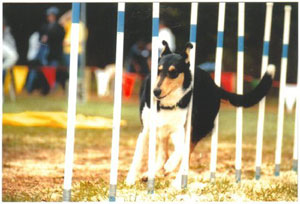 An arched neck is much stronger than one with too little arch or worse yet, a ewe neck (no curve at the nape, but rather, concave). The ability to carry objects properly in obedience is made much easier with proper neck arch. Carting also requires correct neck arch coupled with a good front to assist in pulling. An arched neck is much stronger than one with too little arch or worse yet, a ewe neck (no curve at the nape, but rather, concave). The ability to carry objects properly in obedience is made much easier with proper neck arch. Carting also requires correct neck arch coupled with a good front to assist in pulling.
The collie’s spine is known as the topline and is made up of withers, back, loin, croup and tail. The spine is supple making the correctly built collie in motion the picture of “effortless speed combined with the dog’s herding heritage, requiring it to be capable of changing its direction of travel almost instantaneously.” Backpacking in particular requires a strong spine; however, almost all types of performance work depend on a strong back.
A collie is slightly longer than tall. “Cobby” collie bodies, all the rage a few years ago, are incorrect and impede endurance and flexibility. Square, stocky bodies are correct in some breeds, Keeshonds for instance, but are all wrong for our collies. Conversely, too much body length in the back or the loin causes weakness in the spine, making the collie more susceptible to injury. The length that makes up the back vertebra should be equal to the length that makes up the loin. A weak topline means that the spine is not correct, and also often indicates a problem with the collie’s front assembly. The topline has a great deal to teach us about soundness.
“The back is strong and level, supported by powerful hips and thighs, and the croup is sloped to give a well rounded finish. The loin . . . is slightly arched.” A current major structural defect in our breed is the incorrect croup. I’ve been told that if you have to get to the tail to fault the collie, it’s not a serious flaw. Alas, the faulty croup shows up as a high, curled tail carriage and is part of the collie’s topline. Without the proper gentle slope in croup, not only is the tail carriage unattractive, but the front and rear often look as though they belong to two different dogs when observing side gait. The correct slope allows for a normal pelvis, which determines rear angulations and gives balance to the rear legs. Obviously, when the croup is level or high, endurance, speed, nimbleness, and jumping ability are lost and the collie becomes more susceptible to back injuries. In addition, carting with a collie with a poor croup and tail set can hinder the ability to back up correctly.
“The hocks and stifles are well bent” allowing for flexibility in the rear assembly needed for smooth trotting and jumping. Spring from the rear propels the collie over a jump and makes for much better form. In addition, it lessens front impact once the rear touches down.
Relatively short rear pasterns are needed for endurance and quickness. Terms you once heard from knowledgeable collie breeders such as “well let down hocks” have all but disappeared from our collie vocabulary, and that once highly desirable trait is also disappearing in our collies. What a shame for our breed. Not only are well let down hocks attractive, they’re also practical! Too much distance from the hock joint to the ground, makes for lack of suppleness needed for dog sports. Long hocks make a collie clumsier and contribute to hocking in, or even cow hocks. Since collies are an upright herding breed, and don’t crouch and crawl as Border Collies do, long hocks and cow hocks are a hindrance in the field. Collies with slipping hocks (laxity of the hock joint) should not be expected to perform herding or jumping. Doing so will cause tissue damage and eventual bone or joint deterioration.
Drive from the rear, combined with proper front reach, provides correct convergence when trotting, and both are essential for ground covering. “Viewed from the side, the reasonably long, ‘reaching’ stride is smooth and even, keeping the back line firm and level.” 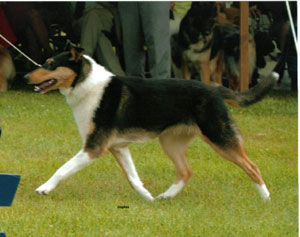 This combination contributes to excellent running times in agility and the ability to cover and regroup uncooperative livestock in herding. This combination contributes to excellent running times in agility and the ability to cover and regroup uncooperative livestock in herding.
Truer words in dogdom than these have rarely been spoken. “Type is undeniably at the center of the dog world – and it should be. After all, breed conformation is founded on type. However, type without a sound, functional structure is rather like breeding balloon animals – producing a recognizable form lacking in substance... Function is as important as type.” (Pat Hastings) A collie should be the picture of gentle curves and balance. No collie should be a shell of a dog that looks pretty but can’t stand up to scrutiny. This approach injures the collie’s health and longevity and causes serious disappointment to owners who want their dogs to live full, interesting and productive lives.
I welcome questions or comments about this article and will include them with a brief discussion in Part 2 if any are forthcoming.
In Part 2 we’ll examine fitness and its role in structure, including sound mental and physical growth and development. A puppy may have inherited a sound structure, but that soundness can be ruined by improper attention to fitness. Nature and nurture go hand in hand in developing a structurally sound collie for performance. Form, function, and fitness are inextricably intertwined!
There are a number of new books and videos out now on performance and structure. I have not had the opportunity to read them yet, but look forward to doing so.
Books and Videos I’ve Read/Viewed and Recommend:
The New Dogsteps: A Better Understanding of Gait through Cineradiograpy
Rachel Page Elliott (book & video)
Dog Locomotion and Gait Analysis
Curtis Brown (book)
The Dog in Action
McDowell Lyon (book)
Puppy Puzzle
Pat Hastings (book & video)
The Collie Standard
AKC (video)
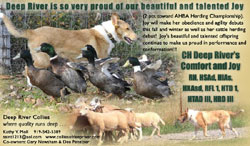 Kathy Moll of Deep River Collies has been showing in Conformation since 1975 and breeding Collies since 1978. She and her training partner, Janie Bristow, (multiple OTCH Gordon Setters) taught training classes from 1979 through 1991. Her first show prospect collie earned his CD in 1977 and her last show/obedience titled collie has earned Obedience and Rally titles in 2007. She is currently training two collies in Obedience -- one in Novice and one in Open and two in Agility. She began taking Herding lessons with her collies after retiring from teaching in 2004 and currently owns a rough champion and a smooth champion with multiple AKC & AHBA Herding trial titles, one with two AKC HXA titles. She is the breeder of 12 PT collies, and eight collies with Started titles and Q's. She has owned or bred numerous breed champions in both varieties and Top 10 collies in both varieties. She also earned the Collie Club of America Presidential Award for Smooth Collie Breeder of the Year for 1998 and 2006 and was tied for the award for 2007 and for Rough Collie Breeder of the Year in 1999. Kathy Moll of Deep River Collies has been showing in Conformation since 1975 and breeding Collies since 1978. She and her training partner, Janie Bristow, (multiple OTCH Gordon Setters) taught training classes from 1979 through 1991. Her first show prospect collie earned his CD in 1977 and her last show/obedience titled collie has earned Obedience and Rally titles in 2007. She is currently training two collies in Obedience -- one in Novice and one in Open and two in Agility. She began taking Herding lessons with her collies after retiring from teaching in 2004 and currently owns a rough champion and a smooth champion with multiple AKC & AHBA Herding trial titles, one with two AKC HXA titles. She is the breeder of 12 PT collies, and eight collies with Started titles and Q's. She has owned or bred numerous breed champions in both varieties and Top 10 collies in both varieties. She also earned the Collie Club of America Presidential Award for Smooth Collie Breeder of the Year for 1998 and 2006 and was tied for the award for 2007 and for Rough Collie Breeder of the Year in 1999.
|